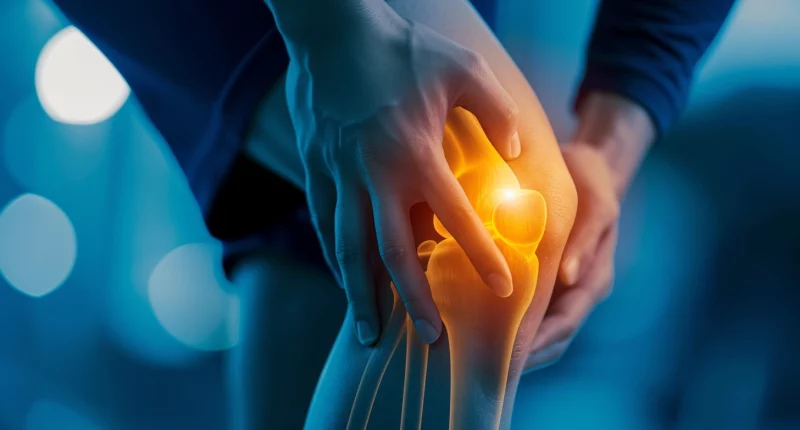Knee contracture
What’s that?
Knee contracture is a persistent limitation of movement amplitude in one or more planes.
About the disease
Knee joint contractures are one of the significant causes that severely limit a person’s physical activity. Both conservative and surgical methods are used to treat patients with this pathology. Among the latter, priority is given to interventions on soft tissues. At the same time, with the long-term existence of the pathological process, soft tissues undergo degeneration, which limits the functionality of surgical intervention. Therefore, different modification techniques of surgical treatment have been proposed. For example, orthopedists use shortening osteotomy for persistent flexion contractures.
Types
In practical traumatology, the following categories of knee contractures are distinguished:
- flexion contracture – the knee is in a state of persistent flexion;
- extension contracture – the knee is in a state of persistent extension.
According to the mechanism of development, contractures are classified into the following types:
- arthrogenic – develops when there is a pathologic change in the structures of the joint;
- myogenic – caused by dystrophic damage to the muscles that drive the knee;
- desmogenic – associated with scarring of fascia, tendons;
- neurogenic – caused by blocking neuromuscular transmission to the corresponding muscle groups (paresis, paralysis);
- immobilization – develops with prolonged wearing of a plaster cast;
- mixed, based on a combination of different etiologic factors.
According to the prevalence of the pathological process is distinguished:
- bilateral contractures;
- unilateral contractures – involving the right or left knee.
Symptoms of knee joint contracture
If the knee is bent less than 45°, the person cannot walk normally (limp). If the knee is bent no more than 90°, the ability to sit on a chair or climb stairs is typically impaired. These conditions significantly impair a person’s quality of life. Symptoms of knee contracture, in addition to flexion-extension limitation, also include pain and discomfort in the knee area.
Reasons
The incidence of extension contractures after femur fractures varies between 20-40%. The formation of flexion contractures in the aftermath of cerebral palsy occurs in 40-50% of cases and as a complication of craniocerebral trauma – in 13-20% of cases.
The leading causes of knee contractures are:
- traumatic injury to the joint;
- degenerative-dystrophic lesion of the cartilaginous plate lining the articulating surfaces of the tibia and femur;
- purulent inflammation of the joint;
- deep burns to the knee area;
- congenital dislocation of the knee;
- underdevelopment of the tibia.
Different mechanisms underlie post-traumatic knee contracture:
- direct damage to joint structures and periarticular tissues;
- the formation of intra-articular connective tissue ties;
- cartilage degeneration on the background of a long period of immobility;
- dystrophic changes in the quadriceps femoris.
Diagnosis
Diagnosis of contractures is based on the data of objective examination and the results of radiological and ultrasound scans. The doctor also evaluates the biomechanics of the joint. In complex clinical cases, computerized or magnetic resonance imaging may be required to detail the cause and severity of the pathology.
Treatment of knee joint contracture
An orthopedic traumatologist will tell you what to do in case of knee contracture and how to improve its functionality. The doctor will choose the optimal treatment method, which is determined by the severity of the pathological process and the causes that led to its development. In most cases, treatment begins with conservative methods, in case their ineffectiveness decides the surgery for knee joint contracture.
Conservative treatment
The main areas of conservative treatment of knee joint contracture are:
- gradual plaster correction, which involves gradual restoration of the limb to a functionally favorable position;
- physical therapy;
- massage, which has a multidirectional effect on the periarticular tissues;
Surgical treatment
The main surgical options performed for knee contractures are:
- Extensive soft tissue surgeries (releases, lengthening, and transplantation of the tibial flexors). They are used for persistent extensor contractures and are pretty traumatic.
- Shortening osteotomies. These are performed in long-standing flexion contractures with chronic contraction and partial scarring of muscles, vessels, and nerves.
- Knee endoprosthetics. Applying optimal access to the knee joint during endoprosthesis in patients with combined contracture allows for restoring the volume and strength of movements in the knee joint in the shortest possible time, reducing the rehabilitation time and improving patients’ quality of life.
- A method of percutaneous osteosynthesis. It can be considered an alternative to bone shortening and, to some extent, soft tissue releases.
The percutaneous osteosynthesis method is undoubtedly used when soft-tissue surgeries fail to achieve the desired result. Using external fixation devices to eliminate knee joint contractures is important in preventing complications from neurovascular formations in long-term contractures.
All these treatment options are available in more than 800 hospitals worldwide (https://doctor.global/results/diseases/knee-contracture). For example, knee osteotomy can be performed in 26 clinics across Turkey for an approximate price of $6.0 K (https://doctor.global/results/asia/turkey/all-cities/all-specializations/procedures/knee-osteotomy).
Prevention
Prevention of knee contractures may consist of the following:
- selection of the optimal method of treatment of fractures of the femur or tibia bones;
- timely treatment of degenerative-dystrophic processes;
- early start of rehabilitation in plaster immobilization;
- regular physical training to increase muscular endurance.
Rehabilitation for knee joint contracture
Rehabilitation for knee contracture includes the following activities:
- development of the joint using therapeutic physical therapy exercises, which are aimed at stretching the musculotendinous compartment;
- carrying out physical procedures that have a resorptive effect and can improve blood supply, have a neurotrophic effect;
- conducting a course of restorative and stimulating massage.




